You could be forgiven for forgetting, but the LCD innovators at Samsung do produce Plasma HDTVs, too. We’ve been asking the company if we can take a look at one of their 3D-capable PDPs – such as the Samsung PS50C6900 – for some time now, but Samsung’s publicity focus is on their LED LCD sets. As a result, we’ve been unable to secure a Samsung plasma TV review sample for many months.
<!-- google_ad_client = 'pub-2887677957235196'; google_ad_slot = '4990177225'; google_ad_width = 336; google_ad_height = 280; //-->
So, the recent delivery of a Samsung PS50C6900 Plasma 3D TV came as a wonderful surprise. These HDTV displays seem to be somewhat difficult to find – in fact, unboxing this 50-inch 1080p 3D Plasma set is the first glimpse we’ve had of a Samsung Plasma television since the CES trade show in January! Samsung’s 2009 Plasmas came infuriatingly close to brilliance, but had some nasty motion processing issues with 50hz content. Since we in Europe are saddled with 50hz TV broadcasts (and likely will be for some time to come), this made it difficult to enthusiastically recommend these HDTVs – even if they did provide great value for money for Blu-ray and gaming use.
Hopeful that Samsung (who have recently released their new Galaxy SIII with HD screen – please visit Dial-a-phone for more info and deals) can deliver the goods this year, we enthusiastically unboxed and investigated the PS50C6900 to see what it could do. Our findings follow.
Note: The specific model we tested was Samsung PS50C6900YKXXU, the 3-pin-plug United Kingdom version. High-street retailers like John Lewis, Comet and Currys, and etailers like Amazon and Dixons may use slightly different model numbers such as Samsung PS50C6900Y, Samsung PS50C6900YK, Samsung PS50C6900YKX or Samsung PS50C6900YKXXU to sell the same plasma 3D TV.
The Samsung PS50C6900’s design is elegant, sleek, and in this writer’s opinion, beautifully styled. The display is almost as thin as the “super slim” LED LCD sets that Samsung is so aggressively promoting, with the 50″ full HD panel being framed by a matte grey border, which features a subtle “brushed steel” design. This, in turn, is framed by a transparent acrylic edge, which features rounded corners. It by no means looks like a budget HDTV display.
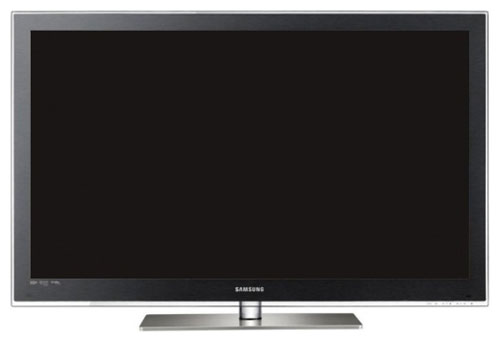
Better yet, the Samsung PS50C6900 does not feature any of the overused and impractical gloss black styling that plagues most current consumer HDTVs. Thanks to the matte finish, the Samsung PS50C6900 looks sleek and professional, and will do many years into the future – something which can’t be said for the scratch-prone gloss black finishes which have sadly become so popular.
The stand supplied with the Samsung PS50C6900 is styled in silver, also with a “brushed steel” finish. While a darker stand might have better complemented the plasma screen itself, the silver look is inoffensive and still looks good. We did find that fitting the plasma panel to the stand was more difficult than Panasonic’s comparable process: the design of the stand meant that we had to turn the Plasma display upside down and attach the stand to it, rather than simply lowering the Samsung PS50C6900 downwards and screwing it in place.
Additionally, once we had finished this process, we weren’t overly enthusiastic about the sturdiness of the stand. Even with the Samsung PS50C6900 screwed in tightly, it did wobble a tiny bit if we gave it a slight shake. While this didn’t concern us greatly (we’re sure Samsung have tested the safety of the product thoroughly themselves), you can only be too careful with a 25kg, 50-inch piece of glass.
Note: By default the Samsung PS50C6900 3D TV doesn’t ship with any 3D glasses, but some stores may offer them in a bundle or through redemption.
When it comes to connectivity, the Samsung PS50C6900 has a lot in common with the company’s ultra-slim LED LCD sets. It’s possible to plug up to 4 HDMI devices directly into the PS50C6900 without adapters (the same goes for the aerial input, the PC “VGA” input, the network connector, headphone socket, and Optical audio output), but the large analogue video connections of the past require break-out adapter cables, which come supplied with the TV. A fully-equipped Samsung PS50C6900 can support one Component video device, one SCART-based device (for example, an older satellite or cable box), and also an RCA Composite video/stereo audio pair, using this method.
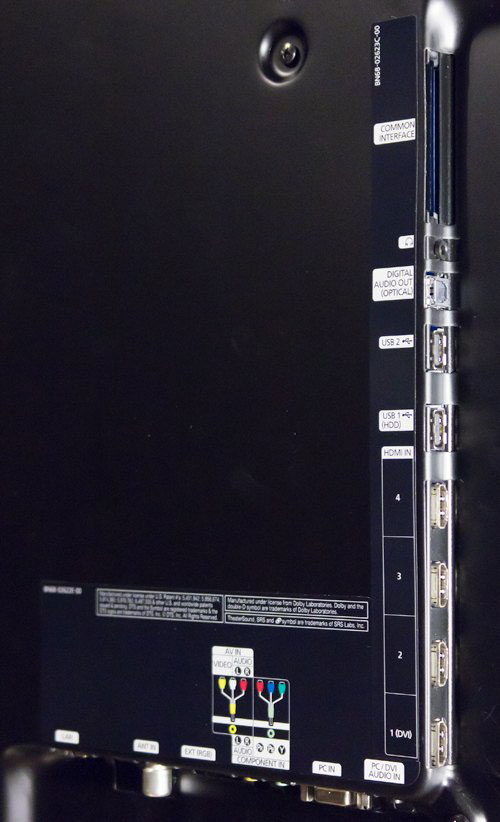 |
| Rear: 4 x HDMI, 2 x USB, Component, VGA, 1x Scart, aerial, ethernet & audio outs |
The PS50C6900 shares the same menu design that Samsung has been using for a good amount of time now. It responds quickly to user input, features easily readable text, and is overall very convenient to use.
We had a look through the menus and were happy to see a full range of picture setup controls. In addition to the controls you’d expect, Samsung’s Plasma displays feature a [Cell Light] slider, which affects the overall light output from the screen. Reducing this control dims the brightest whites the plasma is capable of producing, but unlike an LCD’s comparable [Backlight] control, it does not make blacks blacker by a noticeable extent. Therefore, there’s really no point in lowering the [Cell Light] control, unless you’re in a very dark environment where a dimmer picture would be preferable. We also didn’t see much point in raising it since contrast gains were minimal, and the Samsung PS50C6900 was already pumping out more than enough light for our environment (it defaults to “15” and goes as high as “20”). We would hazard a guess and say that at higher levels, the plasma TV will be more susceptible to temporary image retention, but this is difficult to test objectively.
![[Picture] menu](https://www.hdtvtest.co.uk/news/wp-content/uploads/2018/04/hdtv_Samsung-PS50C6900_picture.jpg) | ![[White Balance] menu](https://www.hdtvtest.co.uk/news/wp-content/uploads/2018/04/hdtv_Samsung-PS50C6900_wb.jpg) |
| [Picture] menus |
The Samsung PS50C6900 also features a basic [Gamma] control (which raises or lowers the HDTV’s Gamma curve, but doesn’t allow for any more fine-tuning), the company’s highly capable Colour Management controls, and 10-point Greyscale control. This level of adjustability means that if the Samsung PS50C6900 doesn’t perform well in its out-of-the-box state, it should be possible to adjust out any colour errors.
There is also a [Motion Judder Canceller] which uses motion analysis to generate fake “inbetween” frames to produce video-like movement from a 24fps film source. You’ll often hear this referred to online as “the soap opera effect”, since it makes high budget films look slightly cheap. We leave these controls off to see the original film as intended.
Note: Our Samsung PS50C6900 review sample was calibrated using Calman Professional, the industry-leading video calibration software.
After turning the Samsung PS50C6900 on, we took it out of its unappealing and unnaturally blue-coloured “Standard” preset. “Standard” would be better named “NON-Standard”, because with its exaggerated, emboldened colours and blue-tinted whites, it doesn’t match any film or TV mastering standards (at least not in the Western hemisphere).
Changing to “Movie” mode brought about a big improvement, but we’re used to looking at calibrated HDTV displays, so familiar tones did appear slightly sickly to our eyes. We then discovered that on the Samsung PS50C6900, the [Colour Space] and [White Balance] settings interact with each other to some extent, meaning that careful calibration will entail back-and-forth checks between the two.
The first main adjustment we made was to the [Brightness] (Black Level) setting. Samsung ships this with much too low a setting, which destroys shadow detail. We had to raise it from its default position of 50 to 57, in order to reveal the correct amount of black. (On Samsung LCD TVs, “50” is usually the ideal setting for Brightness, suggesting that this is what Samsung have optimised the default settings for). For the tech-inclined readers, “25” was the first digital video level that appeared above black by default, whereas a correctly set up TV will show anything above “16” as above black.
We spent a good few hours calibrating Greyscale, Gamma, and Colour on the Samsung PS50C6900 – and then almost tore our hair out in frustration when we realised that this is one of the Samsung flat-screen HDTVs which applies temporal smoothing (selective motion blur) to the incoming video – even when the [Noise Filter] controls are switched “Off”. This meant that we had to switch over to “Game Mode” to avoid this annoyance, which involved re-calibrating.
Why is this smoothing so bad? Because it has the effect of nearly, or completely removing any sort of film grain texture that is critical to the high quality presentation of film material. As well as being aesthetically wrong, this sort of processing strips definition and life out of the picture on screen. While this sort of noise/grain reduction would be appropriate for poorly lit video material, it has no place for professional 35mm films (and even 16mm films, for that matter). We did complain directly to Samsung before about this issue, which appeared to result in a firmware update which lessened the processing, but did not remove it.
Fortunately, there is a fix at hand: [Game Mode]. Enabling [Game Mode] on the Samsung PS50C6900 not only removes subtle colour bleed (Chroma Blur), reduces input lag (more on this later), but also kills the motion-blurring smoothing feature. What’s not to like? Well, as a trade-off for these two advantages, you sadly lose access to the [10p White Balance] feature, but given that this is the only way to see material as-intended, we feel this is a worthwhile sacrifice. All the same, it’s a real pity, because the Greyscale tracking quality of the Samsung PS50C6900 was one of the best we’d ever seen from a Plasma TV when we had access to the 10-point feature, and was comparable even to Pioneer’s efforts on the legendary Kuro plasmas. If you’d like to see what could have been, we’ve uploaded the results of the calibration that we inevitably abandoned here.
Switching over to [Game Mode] locks you into the “Standard” picture preset, which defaults to a blue-tinted “Cool” Greyscale mode. Fortunately, “Warm” can be selected to return a more natural tint to the picture. What follows are the measurements from “Game” mode with the “Warm” preset selected:
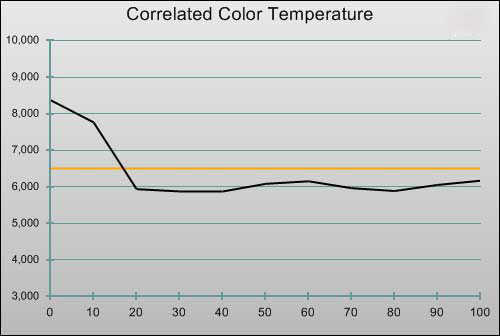 |
| Pre-calibration CCT in [Game] mode |
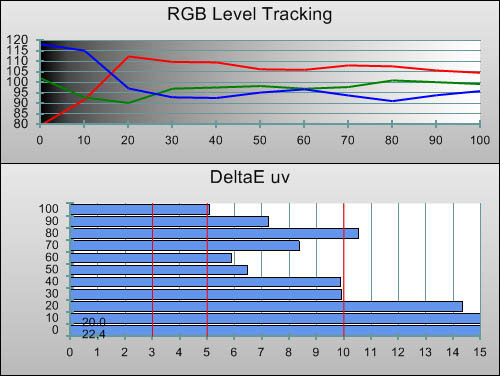 |
| Pre-calibration RGB tracking and delta errors (dEs) |
As the chart suggests, the resulting picture quality this preset mode gave was overly reddish. Considering that we look at perfectly calibrated scenes on a day by day basis, it really is quite difficult to say how visible this error will be to most casual viewers – we’ll take a guess and say “not hugely”.
Seeing as the only way to use [10p White Balance] is to take irritating smoothing as part of the deal, we did the best we could to improve Greyscale quality with only the 2-point [White Balance] control. We tried calibrating at 20 and 80 IRE, as well as 10 and 90 IRE, with the former strategy bringing the best result:
![Post-calibration CCT in [Movie] mode](https://www.hdtvtest.co.uk/news/wp-content/uploads/2018/04/hdtv_Samsung-PS50C6900_post-cct.jpg) |
| Post-calibration CCT in [Game] mode |
![Post-calibration RGB Tracking in [Movie] mode](https://www.hdtvtest.co.uk/news/wp-content/uploads/2018/04/hdtv_Samsung-PS50C6900_post-rgb.jpg) |
| Post-calibration RGB tracking and dEs in [Game] mode |
Unfortunately, without the [10p White Balance] control, we couldn’t neutralise the overly blue 10% stimulus measurement, which hung around in the picture and gave things a slightly “frosty” look. We found this very much to be the lesser of two evils, however, and the overall Greyscale tracking quality was still suitably accurate, meaning that part of the battle for high quality pictures had already been won. At the same time, we can’t understand why Samsung can’t just make its Noise Reduction control optional, rather than forcing us into “Game Mode” for untampered video display.
Gamma tracking on the Samsung PS50C6900 was better than we expected. Typically, we expect Plasma televisions to exhibit slightly crooked and unpredictable Gamma tracking, meaning that the amount of lightness put out by the screen at each brightness level is slightly off (for example, overly dark shadowed areas and dimmed whites are examples of off-kilter gamma tracking). The most obvious manifestation of Plasma displays’ volatile Gamma tracking is with entirely bright screens, where even a small change in the video can result in the overall screen brightness visibly changing.
![Gamma curve in [Movie] mode](https://www.hdtvtest.co.uk/news/wp-content/uploads/2018/04/hdtv_Samsung-PS50C6900_post-gamma.jpg) | |
| Post-Calibration Gamma curve | Post-calibration Gamma tracking |
Although careful adjustment of the 10p White Balance control also allowed for better Gamma tracking, we again had to forego this thanks to Samsung’s unwanted and otherwise undefeatable smoothing process (how about a control to turn that off, Samsung?) Fortunately, the results we got with “Game Mode” enabled were not significantly worse and, in fact, are highly serviceable in their own right.
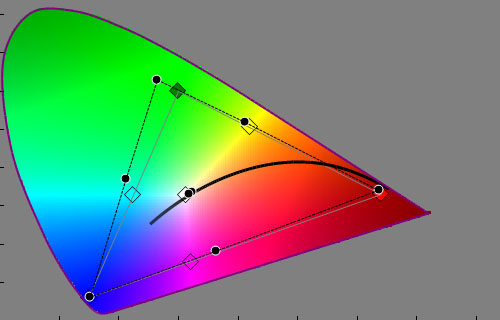 | 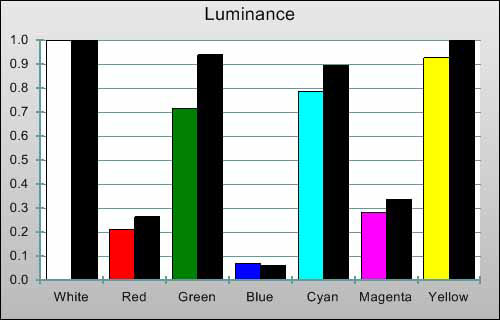 |
| “Auto” Colour Space | “Auto” Colour Decoding |
The Samsung PS50C6900 has several different [Colour Space] options, none of which produce an ideal result without further calibration work. Users who won’t be having their Samsung PS50C6900 calibrated are better off using the “Auto” setting – this results in slight under-saturation and hue errors, but also some highly inaccurate colour decoding. Yellow, Cyan, and most noticeably, Green, all appeared much too bright. Although we make a point of mentioning that Plasma TV displays in particular must have individual calibration attention (that is to say, users can’t simply copy “Best Settings” from the internet), the out-of-the-box performance here is so inaccurate that we will be sharing our calibrated settings at the end of this review, so that owners of uncalibrated PS50C6900s can at least see some improvement.
![Post-calibration CIE chart in [Movie] mode](https://www.hdtvtest.co.uk/news/wp-content/uploads/2018/04/hdtv_Samsung-PS50C6900_post-cie.jpg) | ![Post-calibration Luminance levels in [Movie] mode](https://www.hdtvtest.co.uk/news/wp-content/uploads/2018/04/hdtv_Samsung-PS50C6900_post-colour-lum.jpg) |
| Post-calibration Chromaticity | Post-calibration Colour Decoding |
Fortunately, Samsung’s colour management controls allow for a complete turn-around in the Samsung PS50C6900’s colour quality, and are fully active even in “Game Mode”. Although their colour management menu operates in RGB space (and will require a little bit of familiarisation for those used to working with the more common menus which allow for direct control over Hue/Saturation/Luminance), it is possible to use it to minimise all errors. The results can be seen above: all colours can be adjusted to either perfection, or near-perfection (Red and Magenta both remain just a touch undersaturated). Colour Decoding errors can be completely obliterated.
The end result is rich, vibrant, natural colour. We strongly recommend that any Samsung PS50C6900 owners have their HDTV sets professionally calibrated: it is the biggest post-calibration improvement we’ve seen from an HDTV lately.
As usual, we started by measuring the Samsung PS50C6900’s 3D Mode without any 3D glasses attached to our calibration meter. We do this so we can get an idea of how well the plasma 3D TV can produce linear Greyscale tracking at the higher refresh rate required for stereoscopic 3D.
We did so with great interest, because the only 3D Plasma TV displays we’ve reviewed so far have been from Panasonic. We were curious to see if another Plasma manufacturer had any alternate strategies for 3D imaging. It turns out that the results are much the same: just like Panasonic’s sets, Samsung’s also had trouble producing linear Greyscale tracking in 3D, especially in darker areas of the picture. The [10p White Balance] control is disabled in 3D mode, too, meaning that we couldn’t use this to flatten things out. Simply put, this non-linear, slightly crooked Greyscale tracking means that pictures will take on colour tints and look less natural.
Armed with this knowledge, we attached the Samsung SSG-2100AB 3D glasses to the front of our calibration meter, put the PS50C6900 into 3D Mode, selected the “Movie” picture preset, and took some measurements:
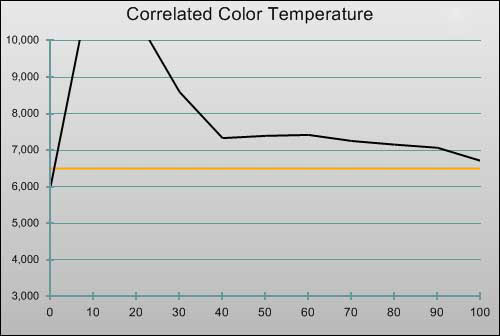 |
| 3D Pre-calibration CCT in [Movie] mode |
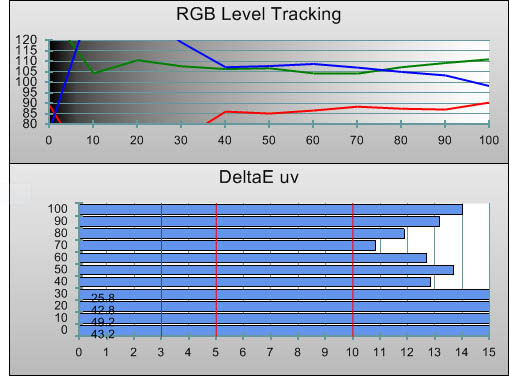 |
| 3D Pre-calibration RGB tracking and delta errors (dEs) |
The measurements we took through the 3D glasses closely reflected the “bare” measurements, only with the obvious change in colour cast (the glasses themselves have a blue-ish tinge when turned on). Unfortunately, the same massive colour bias in shadowed areas remained.
We spent many hours trying to improve this result, but frankly, we think there is little point in attempting 3D calibration of the Samsung PS50C6900 given how uneven its Greyscale tracking is. The improvement we made was minor at best, trading an overly blue image for an overly red one, instead.
Our biggest challenge during 3D calibration was trying to correct the blue-tinted 10% stimulus measurement. Raising the Red control would coat the plasma screen in red PWM noise. This happens on Panasonic’s plasma 3D TVs, too, but Panasonic’s 3D glasses appear to block a sub-field from the viewers’ eyes, meaning that if your calibration on those 3DTVs results in noisy shadows, this probably won’t be visible to the viewer once they’re wearing the glasses. We tried keeping Red locked in place while adjusting Green and Blue proportionally, but ultimately we were left with beetroot-coloured shadows, and like Panasonic’s 3D plasmas, spikes elsewhere in the chart.
We present the results of our 3D calibration simply as proof that we tried, but don’t recommend that anyone goes to the effort of actually doing it, given that the end result is still nothing to get enthusiastic about. Granted, the overall colour temperature is better, but the uncorrectable beetroot-tinted 10% area makes it difficult to claim that it’s a huge improvement.
![3D Post-calibration CCT in [Movie] mode](https://www.hdtvtest.co.uk/news/wp-content/uploads/2018/04/hdtv_Samsung-PS50C6900_3d-post-cct.jpg) |
| 3D Post-calibration CCT in [Movie] mode |
![3D Post-calibration RGB Tracking in [Movie] mode](https://www.hdtvtest.co.uk/news/wp-content/uploads/2018/04/hdtv_Samsung-PS50C6900_3d-post-rgb.jpg) |
| 3D Post-calibration RGB tracking and dEs in [Movie] mode |
![3D Gamma curve in [Movie] mode](https://www.hdtvtest.co.uk/news/wp-content/uploads/2018/04/hdtv_Samsung-PS50C6900_3d-post-gamma.jpg) | |
| 3D Gamma curve in [Movie] mode | 3D Corresponding gamma tracking |
Unfortunately, the Samsung PS50C6900 expects the user to share the same [Colour Space] settings for both 2D and 3D content. This is troublesome, because as most people will have noticed for themselves, the 3D active shutter glasses do impose a colour cast on the image.
Panasonic’s 3D TV offerings are the same, but they feature two configurable “Professional” picture modes, each with its own (more limited) colour management menu, meaning that we can repurpose these into entirely separate 2D and 3D picture modes. Samsung only has one set of Colour controls per-input, meaning that if we wanted to calibrate the 3D display to the HDTV Rec.709 colour spec, we’d have to keep a second BD Player to hand just for 3D, and also assign it its own input. Impractical? We think so, so instead we’ve published the results of the “Auto” mode, which is the next best thing.
![3D Post-calibration CIE chart in [Movie] mode](https://www.hdtvtest.co.uk/news/wp-content/uploads/2018/04/hdtv_Samsung-PS50C6900_3d-post-cie.jpg) |
| 3D Post-calibration CIE chart with reference to HD Rec.709 |
![3D Post-calibration Luminance levels in [Movie] mode](https://www.hdtvtest.co.uk/news/wp-content/uploads/2018/04/hdtv_Samsung-PS50C6900_3d-post-colour-lum.jpg) |
| 3D Post-calibration colour luminance (coloured bars = targets; black bars = measured values) |
| Dead pixels | None |
| Screen uniformity | Perfect (except areas of image retention) |
| Overscanning on HDMI | 0% with [Picture Size] set to “Just Scan“ |
| Blacker than black | Passed |
| Calibrated black level (black screen) | 0.12 cd/m2 (24p/50hz), 0.07 cd/m2 (60hz) |
| Calibrated black level (ANSI checkerboard) | 0.15 cd/m2 (24p/50hz), 0.09 cd/m2 (60hz) |
| Black level retention | Occasional subtle “floating blacks” |
| Primary chromaticity | Excellent after calibration |
| Scaling | Excellent; smooth |
| Video mode deinterlacing | Excellent, very effective jaggies reduction |
| Film mode deinterlacing | Excellent, passed 2:2 PAL and most NTSC cadences! |
| Viewing angle | Excellent (> 150°) |
| Motion resolution | 900 |
| Digital noise reduction | Undefeatable noise smoothing, “Game Mode” required to avoid |
| Sharpness | Defeatable edge enhancement |
| Image retention | Common, noticeable |
| Posterization | Occasional, mild, but not coloured |
| Phosphor trails | Yes, mild yellow-green trails |
| Luma/Chroma bandwidth (Blu-ray) | Full Luma, blurred Chroma, except in “Game” mode |
| 1080p/24 capability | Correct playback in “Cinema Smooth” mode |
| Input lag | 18ms (2D Game Mode), 41ms (3D Game Mode) |
| Full 4:4:4 reproduction | Yes, with input labelled “PC” |
| Default [Standard] mode (2D) | 236 watts |
| Default [Standard] mode (3D) | 306 watts |
| Calibrated [Standard] Game mode (2D) | 220 watts |
| Calibrated [Movie] mode (3D) | 234 watts |
| Standby | 1 watt |
Given that the lure of deep, inky blacks used to be one of the main reasons to consider a Plasma TV over LCD, the Samsung PS50C6900’s black levels were somewhat disappointing. Interestingly, they differ depending on the plasma panel’s refresh rate, making them related to the type of video signal being sent to the TV. They are consistently poorer than what’s seen on Samsung LCD sets.
The Samsung PS50C6900 is at its best when it’s refreshing at 60hz, which it does by default when you input a 24hz (Blu-ray Disc) source, and obviously with American-centric 60hz video sources like modern games consoles or US-region DVDs. In this case, it manages to reach down to 0.07 cd/m2, which is marginally brighter than some mid-range Sony LCD sets. The trouble with 60hz is that film material will play back with a rhythmic judder to movement (also known as “3:2 judder” or “telecine judder”). This may be tolerable for some, especially given the benefit of superior black levels, or a huge annoyance to others.
If you’d rather have smooth, cinema-like motion instead, you can enable the [Cinema Smooth] mode, in which case the TV’s darkest black rises to 0.12 cd/m2 (that’s nearly double the figure measured with 60hz input mathematically, but that doesn’t necessarily mean it leaps out as being “twice as bright” to the eye). For European PAL-centric 50hz sources, the same underwhelming black level was measured. In case you’re wondering, “Game Mode” did not affect black level measurements.
This is a bit of a downer, but frankly, the Samsung PS50C6900 has enough favourable image attributes to stop it from being a killer issue. Let’s not forget that it has the significant Plasma advantage of producing the same contrast quality regardless of where the viewer is situated (its picture doesn’t wash out when viewed from the sides, like an LCD-based screen).
We also tested the Samsung PS50C6900 with our “floating blacks” revealing scene, from the Blu-ray Disc release of Se7en. It didn’t reveal the issue here, but we did see the blacks rise in exactly the same fashion as on Panasonic’s plasma displays with other content. Regardless, we feel that on both sets, it isn’t a huge issue, and once again have to remind readers that this is much less noticeable than the “auto-dimming” that Samsung’s LED-based LCD screens partake in.
To cut right to the chase, the motion clarity of the Samsung PS50C6900 is superior to Panasonic’s PDP efforts this year. On the FPD Benchmark Software test disc, the Samsung PS50C6900 reproduces 900 lines of resolution, compared to the 1080 of Panasonic’s 3D-enabled screens. However, unlike the recently reviewed Panasonic TX-P42GT20 and VT20 displays, Samsung manages to do so without any fuzzy “double images” around moving objects. On the Samsung plasma 3D TV, the entire screen is covered with a light coating of noise, whereas on the Panasonics, the noise would only appear in areas where motion was expected on the next video frame. Samsung’s approach is generally superior, since there are no double images.
We also had a look at the newly redesigned Xbox 360 dashboard, and confirmed the same effect: while Panasonic’s plasmas had a slightly cleaner overall image but displayed some fuzziness during motion, Samsung’s contained an equal amount of noise throughout, meaning that there were no stand-out motion artefacting issues.
When discussing Plasma-specific motion issues, we should also mention Posterization. For the uninitiated, this unwanted motion artefact has been widely discussed in relation to Panasonic’s Plasma televisions, and appears as ridged bands of darker tone surrounding areas of movement. These ridged bands sometimes take on a purple or green tinge on Panasonic’s displays. Samsung’s display is much less affected by this issue, and when posterization does appear on the 50PSC6900, it is monochromatic: there are no purple/green tints.
The PS50C6900’s 3D performance was unquestionably better than the 3D LED LCD sets that Samsung are aggressively pushing, but is a step behind Panasonic’s top-end TX-P50VT20 (although the said Panasonic 3D TV costs roughly twice the price of this Samsung, so that’s understandable). We’ve discussed the Samsung PS50C6900’s trouble with Greyscale tracking in 3D during the calibration section, but just to re-cap, there will be some sort of colour cast to images at all times when watching in 3D. Calibrating is somewhat futile because of the huge colour cast that will persist in shadowed areas.
We had a good look at Sony’s Cloudy With A Chance of Meatballs in 3D, which is a well-styled, genuinely funny and unashamedly cartoon-like animated 3D family film (it’s somewhat derivative, sure, but the same can be said of most animated movies these days). For all these reasons, it is a welcome relief after the months of Monsters Versus Aliens we’ve become accustomed to. Crosstalk in 3D was present almost constantly, but it was at least nowhere near the amount seen on the LCD 3D TVs, which have so much of it that the 3D effect becomes severely compromised. With the Samsung PS50C6900, there was still a great sense of depth, just with some glowing around white objects on screen.
Additionally, unlike Panasonic’s 42″ 3D sets (the TX-P42GT20 and TX-P42VT20), the Samsung PS50C6900 joins Panasonic’s 50-incher in reproducing all 1080 lines of a 3D Blu-ray Disc source. There’s no flickering and no jaggies in fine areas, like there is on the smaller Panasonic 3DTV displays. Our test patterns also confirmed that all of the detail from the source was rearching the 3D plasma screen.
Unfortunately, the PS50C6900 joins Samsung’s 3D LCD sets in forcing all 3D material through a 60hz processing path. The 3D mode on the Samsung PS50C6900 is 60hz-centric, meaning that 50hz (European) TV broadcasts will be rendered with motion judder. 24p movies also have a tiny amount of judder (the “Cinema Smooth” option isn’t available in 3D), but it is much more subtle.
The Samsung PS50C6900 also shares the same 3D scaling issue as the company’s UE46C8000 LED LCD and LE40C750 LCD sets we reviewed this year. This is an issue for any type of 3D content that isn’t in the “Full 3D HD” (3D Blu-ray) format. In particular, scaling is required to adapt Side-by-Side broadcasts – like those on Sky satellite TV – to a full-width 3D picture, and on Samsung 3D televisions, the result is a loss of fine details. Frankly, we’re baffled as to why this is – from what we’ve seen so far, no other TV manufacturer’s implementation of Side-by-Side 3D has this problem, and we’re not sure why such a simple horizontal stretch should result in this sort of artefacting.
Samsung’s HDTV displays have excelled with standard-def material for some time now, and the PS50C6900 is no exception. Video deinterlacing of 480i, 576i and 1080i SD and HD formats was excellent, with almost no jaggedness making it onto the screen.

The look of Samsung’s scaling engine (which performs the actual resizing of SD signals to the HD panel resolution) may be something of an acquired taste, since its edge-adaptive nature means that it ends up producing a more natural picture, rather than a pin-sharp one. For example, other scalers will produce an incredibly sharp picture with some aliasing (jaggedness) present, whereas Samsung’s tends to smooth over such imperfections and present a smoother, more believable image instead. Neither is necessarily better than the other, and personally, we like the look of both.
Film mode detection is also present and working correctly. The Samsung PS50C6900 properly detected PAL 2:2 film material, and presented it with full vertical detail and no jaggedness. The SD handling on this HDTV is really just about as good as it could be.
And finally, after last year’s disappointment, we were delighted to see that the Samsung PS50C6900 does not feature any unwanted motion interpolation (unless requested with the [Motion Judder Canceller]) with 50hz content. The 2009 models featured motion artefacting with 50hz input material, so we are very happy to see clean 50hz reproduction this year.
We had a good look at some of the best examples of actual HD content (Aliens is our favourite live-action Blu-ray Disc at the moment), and also scrutinised test patterns to make sure there were no issues with 2D HD material. As we discussed in the Calibration section, the Samsung PS50C6900 smudges film grain in its default setup, and we had to resort to “Game Mode” to avoid this undesirable processing.
This was well worth it. Prior to using “Game Mode”, the film appeared softer and less, well, filmic. The stubble on Burke’s face turned into a grey smudge upon movement. In some shots, Ripley’s skin texture became baby-smooth whenever she moved. And, due to the motion vector calculation inherent to the process, particles of grain that had not been scrubbed away by the unwanted processing stuck to the edges of actors as they moved, following them like flies.
After calibrating in “Game Mode”, the picture came alive and filmic without any unwanted tampering. The blue-tinted shadows caused by the slightly degraded Greyscale tracking (see the Calibration section) did have an effect on the picture, but it wasn’t blatant nor horribly damaging. Skin tones looked natural and warm when intended by the colourists and lighting technicians, and stylised and tinted when not. After the previous disappointment, we were content that the Samsung PS50C6900 was not tampering with the image.
It was a relief to see that “Game Mode” did not feature any unwanted image quality problems, seeing as it’s not really intended to be used as the main viewing mode. On many HDTVs, “Game” functions tend to introduce motion judder into 24p movies, but not here. Just as with the standard “Movie” mode (which suffers from the unwanted grain reduction), the Game mode can have “Cinema Smooth” enabled from the [Film Mode] menu. This refreshes the Plasma panel at a multiple of the 24fps film frame rate and achieves naturally smooth, filmic presentation without resorting to any unwanted motion interpolation (completely avoiding any “soap opera effect”). However, as noted earlier, “Cinema Smooth” does show a poorer black level.
Test patterns revealed that on the Samsung PS50C6900, high frequencies (the smallest, sharpest details in the HD picture) were rock solid and present on-screen without any distortion. On some other Plasma displays (the Pioneer Kuro PDP-LX5090, for instance), these finest details occasionally appear slightly fuzzy. Being able to reproduce high frequencies like this isn’t a hugely visible benefit for most video content, but it does mean that film grain patterns will appear solid and stable instead of fuzzy. (So long as you’re using “Game Mode”, of course).
Gaming on the Samsung PS50C6900 was, at first, painful – in its default configuration, we had to fight with the controller to aim and control our character in Halo: Reach (input lag measured around 100ms). Fortunately, enabling “Game Mode” cut input lag down to a considerably better figure, with it measuring around 18ms (averaged). Is there anything on this HD TV that “Game Mode” doesn’t fix?
Another point of note that affects almost all users of the Samsung PS50C6900, but especially video gamers, is image retention. Like all of the Samsung (and LG) Plasma displays we’ve reviewed, users of the PS50C6900 will become acquainted with this irritating phenomenon very, very quickly. A static graphic only has to be on screen for a couple of minutes for it to leave a shadowed after-image later. The good news is that the retention clears up almost as quickly as it appears in the first place, and should only really prove troublesome after viewing, rather than during. For example, watching a movie with 2.35:1 letterbox bars will leave patches above and below the screen, but you’ll only notice these after you’ve finished watching the film. Samsung does provide a readily accessible scrolling gradient pattern which can be enabled, and clears up retention quickly.
Not only do Samsung have a “Game” mode, but if you label an input as “PC”, you can bypass even more processing. This brings back [10p White Balance] but means you lose access to the [Colour Space] (colour management system) menu. As another benefit, chroma resolution improves too, with the Samsung PS50C6900 being able to reproduce full-bandwidth (4:4:4) colour from a PC source. Input lag stays the same in this mode.
So, there you have it – if the PS50C6900 is anything to go by, Samsung’s 2010 Plasmas are fairly likeable HDTV displays. Who knew?
Admittedly, the Samsung PS50C6900 could be described as a mixed bag. Its black levels with 24p and 50hz content (that is, a good chunk of what European audiences will be watching) are far removed from the best on the market, and it also suffers from image retention. Additionally, moreso than competing HDTVs from LG and Panasonic, it needs calibration work to result in excellent picture quality, and partakes in revisionist film grain reduction unless you trick it into not doing so.
And yet, in spite of all of this, the Samsung PS50C6900 can be configured to show a very appealing, accurate picture, at a great price. It manages near-perfect colour accuracy, great motion clarity, potentially passable 3D, and crucially, very good value for money (although do factor in calibration at around £200 when considering the price). Its gaming performance is also excellent. Black level, after all, isn’t everything, and there were fewer instances where we found dark scenes lacking in punch than we thought there would be.
The Samsung PS50C6900 faces tough competition from Panasonic’s TX-P50G20, which has fallen to basically the same price over the months. In most areas, the Panasonic is a better Plasma TV, with much better out-of-the-box performance and deeper blacks – but it’s 2D only. Therefore, the people we recommend the PS50C6900 to are those who need a budget 3D display, and also those who are put off by Panasonic’s slightly noisier method of rendering motion. Those who care about aesthetics will also probably agree with us that Samsung’s flat-panel display is considerably more attractive than even Panasonic’s best styling efforts, which have a very practical, industrial feel to them.
We wish Samsung would stop treating its PDP line like an ugly stepchild, because we’d hazard a guess and say that more time spent rectifying the small issues present here would result in an even more recommendable product. For now, this flawed but capable Samsung PS50C6900 achieves “Recommended” status thanks to its excellent (calibrated) colour quality, its attempt at 3D, and its price. It has flaws, no question – but maybe the 2011 Samsung plasma lineup will be better yet. If we’re lucky, we’ll get to test one earlier than the end of 2011!

The post-calibration settings for our Samsung PS50C6900 review unit has been published on our Facebook page.
<!-- google_ad_client = 'pub-2887677957235196'; google_ad_slot = '0693194791'; google_ad_width = 336; google_ad_height = 280; //-->